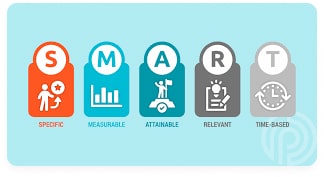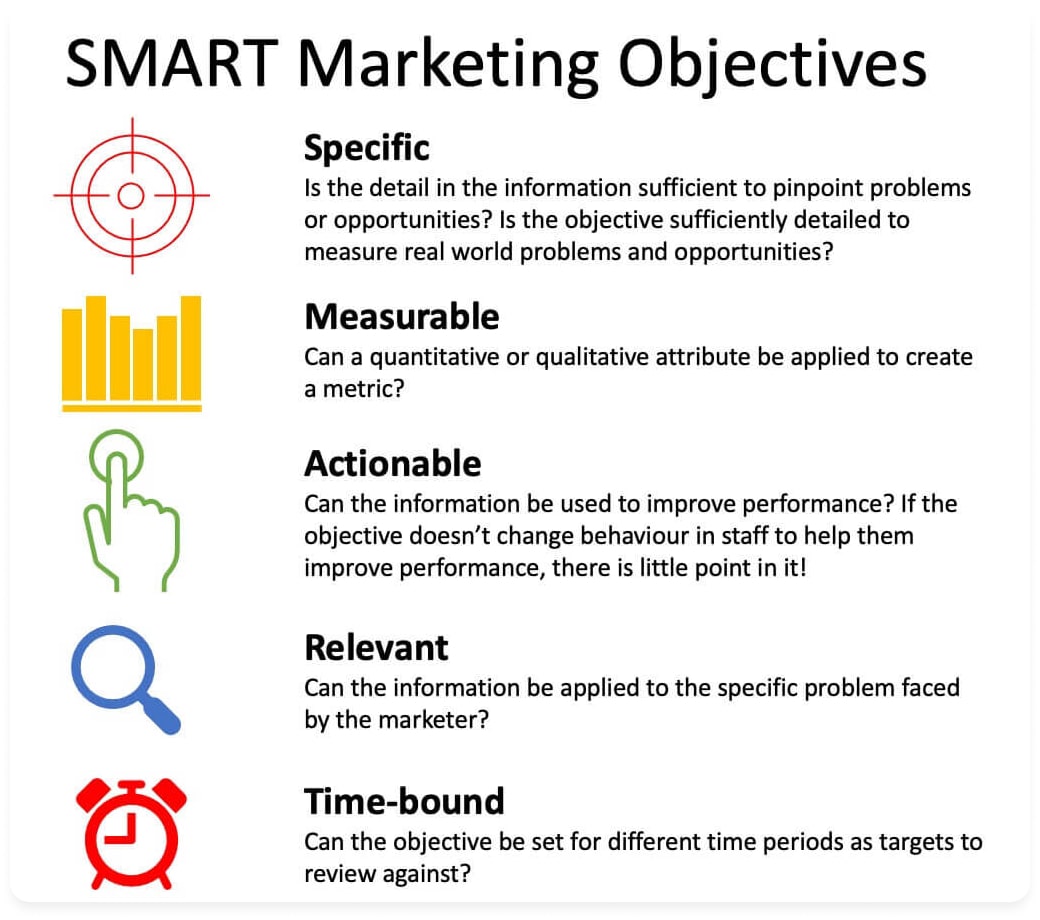Setting clear and achievable goals has become more crucial than ever in the evolving landscape of digital marketing. Clear goals guide businesses toward success. However, not all goals are equally important. To navigate this, savvy marketers have developed a framework that promises clarity and effectiveness—SMART goals. SMART goals are a roadmap that leads wishful thinking into a tangible reality.
In this guide, we’ll delve into the intricacies of SMART marketing goals to empower you with the knowledge to make a stealing marketing strategy. Let’s get into it!
SMART marketing – Why is it necessary?

SMART – an acronym for Specific, Measurable, Actionable, Relevant, and Time-bound – is a way to set and achieve goals.
Whether you’re a novice eager to understand how to define your goals or a seasoned marketer looking to level up your goal-setting approach, join us to demystify SMART marketing goals.
Along the way, we’ll explore real-world examples that bring these principles to life, illustrating how businesses across industries have harnessed the power of SMART goals to turn aspirations into achievements.
What are SMART goals in marketing?
Research shows that marketers who set goals are 376% more likely to report success, and 70% achieve their goals. YES! That’s true. Setting goals works like magic since it clears fog from the brain and helps A LOT in planning.
SMART marketing goals can be the ultimate solution to achieve the desired business results. They are tailor-made and, therefore, easier to achieve.
The SMART goals are not something in the air but are well-defined, understandable, and easily pursued goals.
Write the input-based goals, not the output-based ones.
Here is a breakdown of SMART marketing goals:
1. Specific
The first letter of SMART stands for “Specific.” This means the goals should be well-defined and specific. Instead of listing wishes in a goal list, you should be specific about what you want to achieve.
An example of a vague goal is” increase business sales.” Change it into a specific goal like “increasing online sales by 10% in Q1 of 2024.”
2. Measurable
The second point is to have a measurable goal. Goals should have specific criteria that allow you to track performance and make decisions accordingly.
Take the above example; a 10% increase in online sales is measurable and helps measure the target.
3. Achievable
The third point ensures that goals should be realistic and achievable. Setting unrealistic goals demotivates you and makes success difficult in the long run. So keep in mind that goals are feasible with given resources.
4. Relevant
The goals must align with the business’s mission and vision. They must align with business objectives and meaningfully contribute to the organization’s success.
6. Time-bound
Lastly, you must define the timeframe to achieve the goal. Adding the deadline helps prioritise the task and achieve it.
For example, increasing sales by 10% in Q1 establishes a clear time frame for achieving the goals.
Read also: 17+ Best Advertising and Marketing Strategies for Small Businesses
Example of SMART marketing goals

By designing their market strategies smartly, organizations enhance their ability to plan and implement strategies and get results. This approach gives laser-focused ideas to work towards organizational goals.
Here are some more examples of SMART marketing goals in product and service-based businesses to get ideas for developing market strategies smartly:
1. Getting more social media engagement
SMART goal: Increase traffic on all social media channels by 15% in Q2
2. Increase brand awareness
SMART goal: Increase awareness of our brand through partnerships with top industry creators in the next 3 months.
3. Generate more leads for business
SMART goal: Gnererate 10 monthly leads for business using organic marketing strategies.
4. Increase customer retention
SMART goal: Retain 40% of monthly customers using a promotional code strategy.
5. Rank higher in search engine
SMART goal: Elevate blog position from 10th page to 3rd page of search engine using effective SEO strategies in 2 months.
6. Talk about social media marketing
SMART goal: Provide a step-by-step guide for social media content creation on Instagram in the next 2 months.
You can use the following template to make SMART marketing goals for business:
Achieve (XYZ) using (XYZ strategy) in (time).
Setting SMART marketing goals using AI (ChatFAI)
Setting marketing goals could be a daunting task, but no more.
AI can be your strategic partner in setting specific and achievable goals. The combination of artificial intelligence and machine learning makes the AI chatbots the final stop in goal setting.
ChatFAI proved to be a helping hand in this regard. This AI tool is an all-in-one solution to set SMART goals that are easy to work on.
Let me explain how you can use ChatFAI to set SMART marketing goals for your business.
1. Search ChatFAI and log in with your credentials.
If you already have an account, skip this point and move to the next one.
2. Click on start chatting.
3. Click on the + sign in the top left corner and click “New Chat.”
4. Click on “New Character.”
5. Add the character’s name and bio, and set a profile picture.

Pro tip: Keep bio specific and add the keyword “expert marketing strategist” so that the character can help develop the marketing strategy.
Here is the bio of the character I developed on ChatFAI:
Mike is a business graduate specialising in marketing. He is an expert marketing strategist who helped develop marketing strategies for small businesses. He has 10+ years of experience in crafting marketing goals for businesses that are specific and achievable promptly.
6. Let’s talk with him about the best marketing tips to help your business shine.
Prompt: Hi Mike, I’m a small business owner who runs my stationery brand. My target audience is students. My goal is to increase sales and revenue. Help me make SMART marketing goals.
Here is the SMART goal he provided:
Increase the number of repeat purchases from your target audience by 20% within the next quarter.

You can get into the conversation with Mike or make your own character to get started.
Wrap-up
Setting marketing goals is challenging. Developing goals that align with the business’s vision and achieve objectives is difficult. Thanks to AI, this tedious task has become much easier.
The blog post provides a step-by-step guide to setting SMART marketing goals. ChatFAI can help you create a killer marketing strategy for your business.
FAQs
Q: What is an example of a SMART goal in PR?
Here is an example of a SMART goal in PR:
Increase social media following by 10% by partnership with 3 influencers in 3 months.
Q: What is a SMART goal in business?
SMART goals are not merely words on paper but actionable goals that can be achieved with effort. The SMART goal for businesses could be to increase sales by 10% using the organic lead generation methods in 2 months.
Q: What are the 5 SMART goals examples?
Here are 5 examples of SMART goals:
- Gain 1000 new subscribers on the YouTube channel by posting 4 weekly posts in Q1.
- Increase email open rate by 16% using storytelling techniques for headlines for the next three months.
- Enroll 5 coaching clients in our brand-new course using organic marketing techniques within 30 days.
- Increase brand awareness by 30% using a collaboration approach with local influencers for the next 6 months.
- Double business sales in the next 1 year using social media marketing techniques.